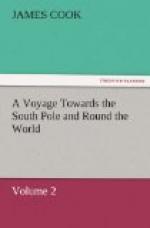[See Vol I. p40. “Which is nearly the same difference as the day before...”]
In observing the variation of the magnetic needle, we found, as usual, our compasses differ among themselves, sometimes near 2 deg.; the same compass too, would sometimes make nearly this difference in the variation on different days, and even between the morning and evening of the same day, when our change of situation has been but very little. By the mean of the observations which I made about Erromango; and the S.E. part of these islands, the variation of the compass was 10 deg. 5’ 48” E.; and the mean of those made about Tierra del Espiritu Santo, gave 10 deg. 5’ 30” E. This is considerably more than Mr Wales found it to be at Tanna. I cannot say what might occasion this difference in the variation observed at sea and on shore, unless it be influenced by the land; for I must give the preference to that found at sea, as it is agreeable to what we observed before we made the islands, and after we left them.
CHAPTER VIII.
An Account of the Discovery of New Caledonia, and the Incidents that happened while the Ship lay in Balade.
1774 September
At sun-rise on the 1st of September, after having stood to S.W. all night, no more land was to be seen. The wind remaining in the S.E. quarter, we continued to stand to S.W. On the 2d, at five o’clock, p.m., being in the latitude 18 deg. 22’, longitude 165 deg. 26’, the variation was 10 deg. 50’ E.; and at the same hour on the 3d, it was 10 deg. 51’, latitude at that time 19 deg. 14’, longitude 165 deg. E. The next morning, in the latitude of 19 deg. 49’ longitude 164 deg. 53”, the amplitude gave 10 deg. 21’, and the azimuths 10 deg. 7’ E. At eight o’clock, as we were steering to the south, land was discovered bearing S.S.W., and at noon it extended from S.S.E. to W. by S., distant about six leagues. We continued to steer for it with a light breeze at east, till five in the evening, when we were stopped by a calm. At this time we were three leagues from the land, which extended from S.E. by S. to W. by N., round by the S.W. Some openings appeared in the west, so that we could not tell whether it was one connected land or a group of islands. To the S.E. the coast seemed to terminate in a high promontory, which I named Cape Colnett, after one of my midshipmen who first discovered this land. Breakers were seen about half-way between us and the shore; and, behind them, two or three canoes under sail, standing out to sea, as if their design had been to come off to us; but a little before sun-set they struck their sails, and we saw them no more. After a few hours calm, we got a breeze at S.E., and spent the night standing off and on.




